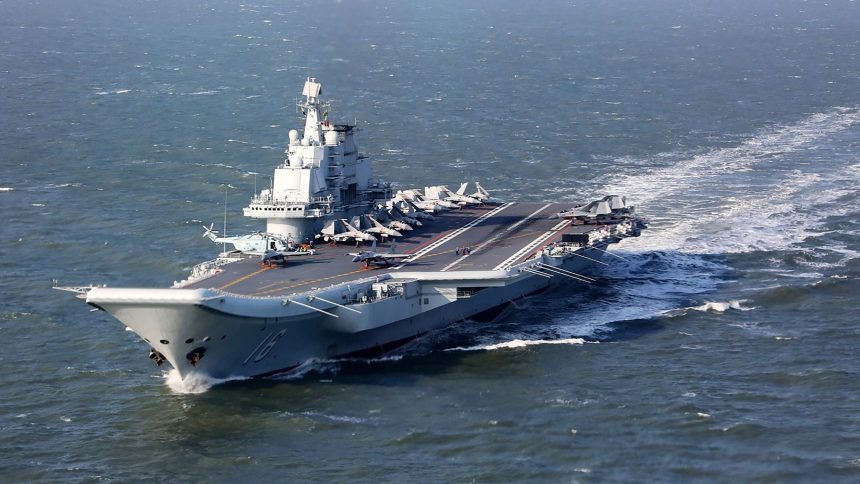Japan’s Joint Staff marked spots in the Pacific waters east of the Philippines as ‘newly announced locations’ for the Chinese navy.
The PLA Navy’s Liaoning CSG (Carrier Strike Group), operating in the western Pacific’s SCS (South China Sea) since Sep. 17-18, 2024, saw approximately 130 take-offs and landings by carrier-based aircraft and around 90 helicopter operations from Sep. 27 to Oct. 1, the Japan MoD reported. This totalled 220 takeoffs and landings in the four-five day period.
For the entire duration between Sep. 20 and Oct. 1, the JMSDF (Japan Maritime Self-Defense Force), that sent its own warships to observe the Chinese flotilla, counted a total number 630 operations – fighters and helicopters combined. The Liaoning had clocked the figures prior to this in December 2022.
The Liaoning CSG first raised eyeballs when it passed through Japan’s Yonaguni and Iriomote islands, which are the southernmost features in its Ryukyu island chain that ends a little away from Taiwan’s northeastern waters. A map of its movement showed the naval armada spotted moving southwest into waters east of The Philippines towards the Celebes Sea, off its main island of Mindanao from Oct. 1 to Oct. 2.
【中国海軍艦艇の動向について】https://t.co/ix5rHCGztC#海上自衛隊 は、9月20日(金)から26日(木)にかけて、中国海軍ク… https://t.co/KmzRuqMuO1 pic.twitter.com/g4v5hlTrrQ
— 防衛省統合幕僚監部 (@jointstaffpa) October 1, 2024
The Japan MoD’s Joint Staff observed this, and other spots in the Pacific waters east of the Philippines as “newly announced locations,” implying Chinese warships have not exercised here before. However, the PLA Navy is not unfamiliar with this southern part of the SCS, as the color-coded marks on the map distinguishing the known and the new locations are only peppered around the same general area.
Interestingly, on Oct. 2, 2024, the Marine Rotational Force-Southeast Asia announced having arrived in the Philippines as part of the third annual rotational deployment for their six month stint. Simultaneously, other U.S. and Allied forces too tried to show their presence in the region in response to the Chinese exercise. The U.S. Navy 7th Fleet shared images of the Arleigh Burke-class guided missile destroyer USS Howard, with warships from the Philippines, Australian, New Zealand and Japanese navies.
Sortie frenzy
Liaoning, the PLA Navy’s first aircraft carrier, was modified and restructured from the Soviet-era Kuznetsov-class carrier and commissioned in September 2012. Its primary air arm consists of the J-15 carrier-borne fighter, itself a Chiese-derivative of the Russian Su-33. Global Times reported in mid-September that a “new type” of warplane, speculating it could be the carrier-borne twin-engine J-31/J-35, was “tested earlier this year” from the Liaoning.
Whether the test involved an actual flight from the STOBAR (Short Take-Off Barrier-Arrested) ski-ramp or a mockup model is not yet clear. But the GT report did carry an image showing “full-scale models of a J-35 and the J-15 in waterproof cloth on the Liaoning’s flight deck in Dalian.”
Recently #China’s aircraft carrier Liaoning (CV16) deployed to the Western Pacific for training, this image shows its operational area along with key observations, the vessel is likely headed to the South China Sea now after completing nearly 630 successful sorties pic.twitter.com/GMWdDHz2Wb
— Damien Symon (@detresfa_) October 2, 2024
During the drills, the JMSDF saw the Liaoning being accompanied by the Luyang III-class, Renhai-class guided missile destroyers and the Fuyu-class fast combat support ship (or a naval fleet replenishment tanker) that was photographed transferring fuel to the Liaoning at one point. The JMSDF deployed the Escort Division 2’s and the Escort Division 8’s, JS Asahi and JS Kirisame for “surveillance and information gathering.”
Interestingly, the Liaoning had achieved the feat prior to this in Dec. 2022, with 130 launches and recoveries in the western Pacific. At that time too it was shadowed by the JMSDF. But that same year in May, the Liaoning saw more than 300 fighter and helicopter sorties in the western Pacific. Global Times said: “It was deemed by observers as the most sortie-intensive exercise by the Chinese carrier in the region at the time. This means that the aircraft sorties during the four days were more than twice as intensive as the exercise in May.”
Interesting pics from Chinese Liaoning carrier. CCTV7, Junshi Baodao, 25Sept. Had not previously seen munitions aboard PLAN carriers. Will be interesting to see when and if J-15 hefting an anti-ship cruise missile. Has that occurred? Of course, catapults will alter the equation. pic.twitter.com/vtD6fkhRpE
— Lyle Goldstein (@lylegoldstein) September 26, 2024
Purpose of the drill
The drill has a simple aim of getting the crew the pilots used to high-tempo operations for a conventional war with a peer adversary like the U.S. Navy in punishing and strainful conditions of carrier aviation. The U.S Navy terms this as SGR (Sortie Generation Rate), which saw significantly high numbers during the USS Eisenhower’s deployment on the Red Sea.
It also serves as a message to Taiwan and Japan about the PLA Navy’s ability to conduct full-blown carrier-borne fighter-bomber sorties from around its shores. During the drills in 2022, Global Times added that the J-15s were carrying air-to-air missiles. But it is difficult to identify the munitions on the fighters given the long distance shot of the Liaoning’s carrier operations.









